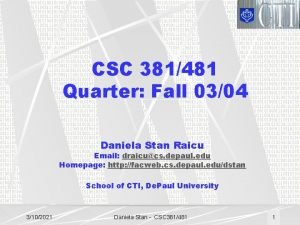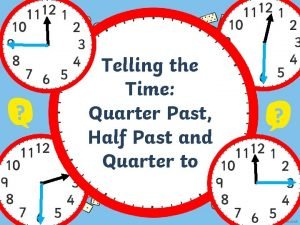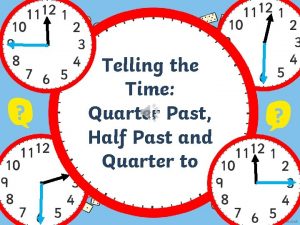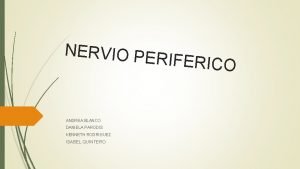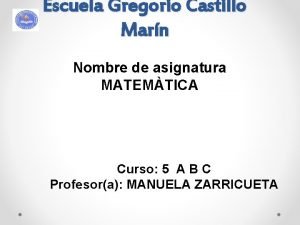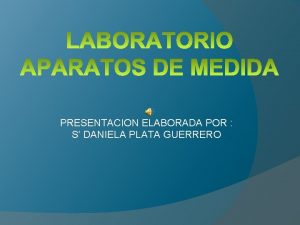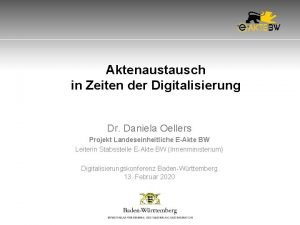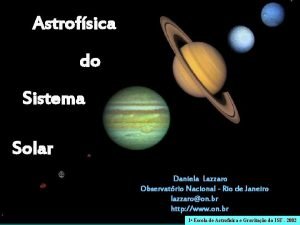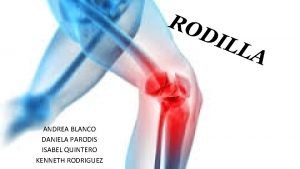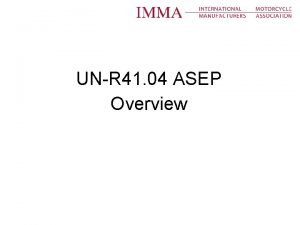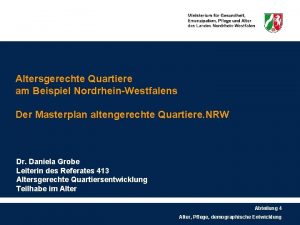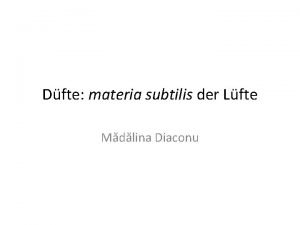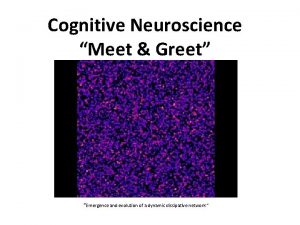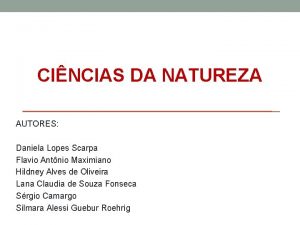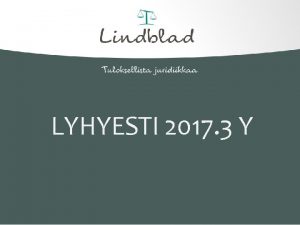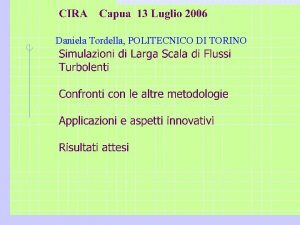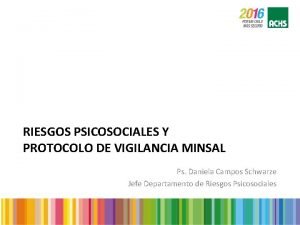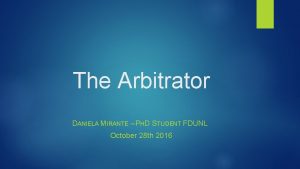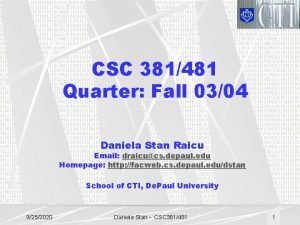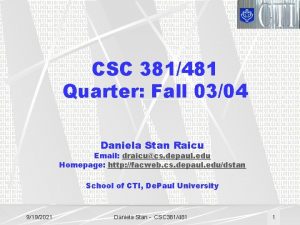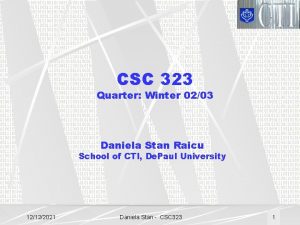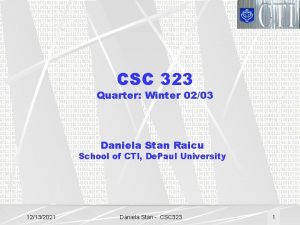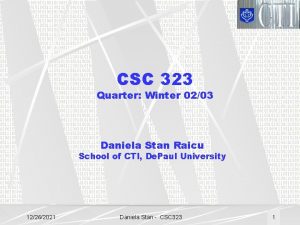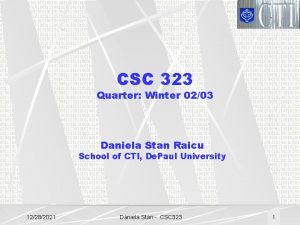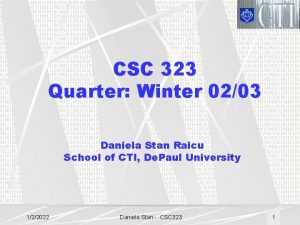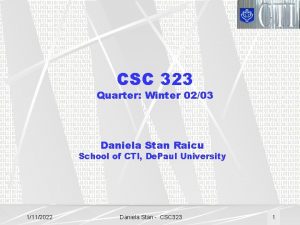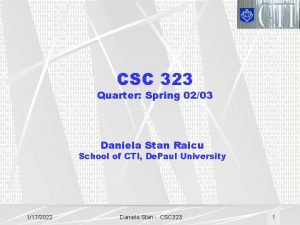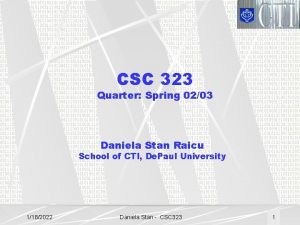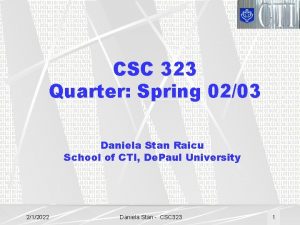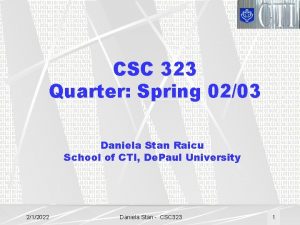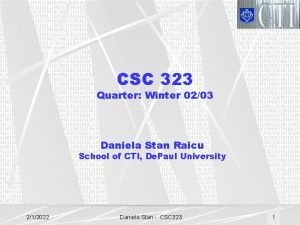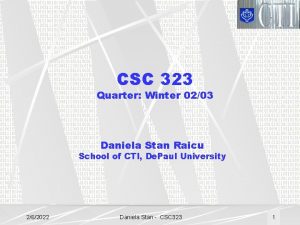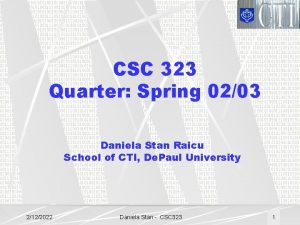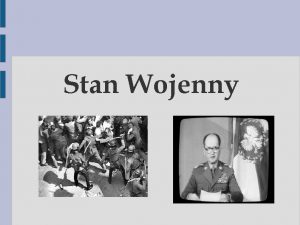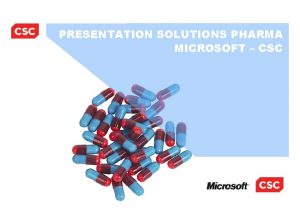CSC 381481 Quarter Fall 0304 Daniela Stan Raicu


















































- Slides: 50

CSC 381/481 Quarter: Fall 03/04 Daniela Stan Raicu Email: draicu@cs. depaul. edu Homepage: http: //facweb. cs. depaul. edu/dstan School of CTI, De. Paul University 3/10/2021 Daniela Stan - CSC 381/481 1

Outline Ø Chapter 2: Digital Image Fundamentals Ø Section 2. 4: Image sampling and quantization Ø Ø Ø Basic concepts Representing digital images Spatial and gray-level resolution Ø Section 2. 5: Some basic relationships between pixels Ø Ø Neighbors of a pixel Adjacency, connectivity, regions, and boundaries Distance measures Image operations on a pixel basis Ø Algebra review Ø Matlab tutorial 3/10/2021 Daniela Stan - CSC 381/481 2

Fundamentals of Digital Images x Origin y Image “After snow storm” f(x, y) w An image: a multidimensional function of spatial coordinates. w Spatial coordinate: (x, y) for 2 D case such as photograph, (x, y, z) for 3 D case such as CT scan images (x, y, t) for movies w The function f may represent intensity (for monochrome images) or color (for color images) or other associated values. 3/10/2021 Daniela Stan - CSC 381/481 3

Digital Images Digital image: an image that has been discretized both in spatial coordinates and associated value. w Consist of 2 sets: (1) a point set and (2) a value set w Can be represented in the form I = {(pos, a(pos)): pos ÎX, a(pos) Î F} where X and F are a point set and value set, respectively. w An element of the image, (pos, a(pos)) is called a pixel where - pos is called the pixel location and - a(pos) is the pixel value at the location pos 3/10/2021 Daniela Stan - CSC 381/481 4

Image Types Intensity image or monochrome image: each pixel corresponds to light intensity normally represented in gray scale (gray level). Gray scale values 3/10/2021 Daniela Stan - CSC 381/481 5

Image Types Color image or RGB image: each pixel contains a vector representing red, green and blue components. RGB components 3/10/2021 Daniela Stan - CSC 381/481 6

Image Types Binary image or black and white image Each pixel contains one bit : 1 represent white 0 represents black Binary data 3/10/2021 Daniela Stan - CSC 381/481 7

Image Types Index image Each pixel contains index number pointing to a color in a color table Color Table Index No. Index value 3/10/2021 Red Green Blue component 1 0. 5 0. 3 2 1. 0 0. 0 3 0. 0 1. 0 0. 0 4 0. 5 5 0. 2 0. 8 0. 9 … … Daniela Stan - CSC 381/481 8

Image Sampling Image sampling: discretize an image in the spatial domain Spatial resolution / image resolution: pixel size or number of pixels 3/10/2021 Daniela Stan - CSC 381/481 9

How to choose the spatial resolution = Sampling locations Sampled image Original image Spatial resolution 3/10/2021 Under sampling, we lost some image details! Daniela Stan - CSC 381/481 10

Original image How to choose the spatial resolution : Nyquist Rate 2 mm 1 mm Sampled image No detail is lost! Minimum Period Spatial resolution (sampling rate) = Sampling locations 3/10/2021 Nyquist Rate: Spatial resolution must be less or equal half of the minimum period of the image or sampling frequency must be greater or equal twice of the maximum frequency. Daniela Stan - CSC 381/481 11

Effect of Spatial Resolution 3/10/2021 Daniela Stan - CSC 381/481 12

Effect of Spatial Resolution 3/10/2021 Daniela Stan - CSC 381/481 13

Effect of Spatial Resolution Down sampling is an irreversible process. 256 x 256 pixels 128 x 128 pixels 64 x 64 pixels 32 x 32 pixels 3/10/2021 Daniela Stan - CSC 381/481 14

Image Quantization Image quantization: discretize continuous pixel values into discrete numbers Color resolution/ color depth/ levels: - No. of colors or gray levels or - No. of bits representing each pixel value - No. of colors or gray levels Nc is given by where b = no. of bits 3/10/2021 Daniela Stan - CSC 381/481 15

Image Quantization The number of bits required to store a digitized image of size M by N and having L=2 k (Nc from the previous slide) gray levels is equal to M *n*k. 3/10/2021 Daniela Stan - CSC 381/481 16

Image Quantization : Quantization function Quantization level Nc-1 Nc-2 The example shows that perceived brightness is not a simple function of the intensity. 2 1 0 Light intensity Darkest 3/10/2021 Brightest Daniela Stan - CSC 381/481 17

Effect of Quantization Levels 3/10/2021 256 levels 128 levels 64 levels 32 levels Daniela Stan - CSC 381/481 18

Effect of Quantization Levels (cont. ) 16 levels 8 levels In this image, it is easy to see false contouring: this effect is caused by insufficient number of gray levels in smooth areas of a digital image. 3/10/2021 4 levels Daniela Stan - CSC 381/481 2 levels 19

Effect of Quantization Levels (cont. ) 3/10/2021 Daniela Stan - CSC 381/481 20

Effect of Quantization Levels (cont. ) 3/10/2021 Daniela Stan - CSC 381/481 21

Basic relationship between pixels (0, 0) y x (x-1, y-1) (x+1, y-1) (x-1, y) (x+1, y) (x-1, y+1) (x+1, y+1) Conventional indexing method 3/10/2021 Daniela Stan - CSC 381/481 22

Neighbors of a Pixel Neighborhood relation is used to tell adjacent pixels. It is useful for analyzing regions. 4 -neighbors of p: (x, y-1) (x-1, y) p (x+1, y) N 4(p) = (x, y+1) (x-1, y) (x+1, y) (x, y-1) (x, y+1) 4 -neighborhood relation considers only vertical and horizontal neighbors. Note: q Î N 4(p) implies p Î N 4(q) 3/10/2021 Daniela Stan - CSC 381/481 23

Neighbors of a Pixel (cont. ) (x-1, y-1) (x+1, y-1) (x-1, y) p (x+1, y) (x-1, y+1) (x+1, y+1) 8 -neighbors of p: N 8(p) = (x-1, y-1) (x+1, y-1) (x-1, y) (x+1, y) (x-1, y+1) (x+1, y+1) 8 -neighborhood relation considers all neighbor pixels. 3/10/2021 Daniela Stan - CSC 381/481 24

Neighbors of a Pixel (cont. ) (x-1, y-1) (x+1, y-1) Diagonal neighbors of p: p ND(p) = (x-1, y+1) (x+1, y+1) (x-1, y-1) (x+1, y-1) (x-1, y+1) (x+1, y+1) Diagonal -neighborhood relation considers only diagonal neighbor pixels. 3/10/2021 Daniela Stan - CSC 381/481 25

Connectivity is adapted from neighborhood relation. Two pixels are connected if they are in the same class (i. e. the same color or the same range of intensity) and they are neighbors of one another. For p and q from the same class w 4 -connectivity: p and q are 4 -connected if q Î N 4(p) w 8 -connectivity: p and q are 8 -connected if q Î N 8(p) w mixed-connectivity (m-connectivity): p and q are m-connected if q Î N 4(p) or q Î N 4(p) and N 4(p) Ç N 4(p) =Æ 3/10/2021 Daniela Stan - CSC 381/481 26

Adjacency A pixel p is adjacent to pixel q if they are connected. Two image subsets S 1 and S 2 are adjacent if some pixel in S 1 is adjacent to some pixel in S 2 S 1 S 2 We can define type of adjacency: 4 -adjacency, 8 -adjacency or m-adjacency depending on type of connectivity. 3/10/2021 Daniela Stan - CSC 381/481 27

Path A path from pixel p at (x, y) to pixel q at (s, t) is a sequence of distinct pixels: (x 0, y 0), (x 1, y 1), (x 2, y 2), …, (xn, yn) such that (x 0, y 0) = (x, y) and (xn, yn) = (s, t) and (xi, yi) is adjacent to (xi-1, yi-1), i = 1, …, n p q We can define type of path: 4 -path, 8 -path or m-path depending on type of adjacency. 3/10/2021 Daniela Stan - CSC 381/481 28

Path (cont. ) 8 -path p m-path p q q 8 -path from p to q results in some ambiguity 3/10/2021 Daniela Stan - CSC 381/481 p q m-path from p to q solves this ambiguity 29

Distance For pixel p, q, and z with coordinates (x, y), (s, t) and (u, v), D is a distance function or metric if w D(p, q) ³ 0 (D(p, q) = 0 if and only if p = q) w D(p, q) = D(q, p) w D(p, z) £ D(p, q) + D(q, z) Example: Euclidean distance 3/10/2021 Daniela Stan - CSC 381/481 30

Distance (cont. ) D 4 -distance (city-block distance) is defined as 2 2 2 1 0 1 2 2 Pixels with D 4(p) = 1 is 4 -neighbors of p. 3/10/2021 Daniela Stan - CSC 381/481 31

Distance (cont. ) D 8 -distance (chessboard distance) is defined as 2 2 2 2 2 1 1 1 2 1 0 1 2 1 1 1 2 2 2 Pixels with D 8(p) = 1 is 8 -neighbors of p. 3/10/2021 Daniela Stan - CSC 381/481 32

Template, Window, & Mask Operation Sometime we need to manipulate values obtained from neighboring pixels Example: How can we compute an average value of pixels in a 3 x 3 region center at a pixel z? 2 9 7 5 7 2 3/10/2021 4 2 2 2 4 5 1 2 3 4 9 7 3 6 2 5 2 3 Image 6 4 6 1 1 2 2 4 7 5 2 8 Daniela Stan - CSC 381/481 Pixel z 33

Template, Window, and Mask Operation (cont. ) Step 1. Selected only needed pixels 1 2 6 2 9 7 5 7 2 3 9 3 2 2 4 7 6 5 3 4 6 1 1 2 4 7 5 2 8 2 2 2 4 5 3/10/2021 … 3 9 3 4 7 6 4 6 1 … … 2 4 … Pixel z Daniela Stan - CSC 381/481 34

Template, Window, and Mask Operation (cont. ) … Step 2. Multiply every pixel by 1/9 and then sum up the values 4 4 9 7 6 3 6 1 … … … 3 X 1 1 1 1 1 3/10/2021 Mask or Window or Template Daniela Stan - CSC 381/481 35

Template, Window, and Mask Operation (cont. ) Question: How to compute the 3 x 3 average values at every pixels? 2 4 1 2 6 2 9 7 5 7 3 9 3 2 4 7 6 5 4 6 1 1 4 7 5 2 2 4 Solution: Imagine that we have a 3 x 3 window that can be placed everywhere on the image Masking Window 3/10/2021 Daniela Stan - CSC 381/481 36

Template, Window, and Mask Operation (cont. ) Step 1: Move the window to the first location where we want to compute the average value and then select only pixels inside the window. Step 2: Compute 2 4 1 2 6 2 2 4 1 the average value 9 2 3 4 4 4 9 2 3 7 2 5 2 7 4 9 3 2 7 6 5 6 7 1 5 1 2 7 2 9 Sub image p Original image Step 4: Move the window to the next location and go to Step 2 Daniela Stan 3/10/2021 4. 3 CSC 381/481 Step 3: Place the result at the pixel in the output image Output image 37

Template, Window, and Mask Operation (cont. ) The 3 x 3 averaging method is one example of the mask operation or Spatial filtering. w The mask operation has the corresponding mask (sometimes called window or template). w The mask contains coefficients to be multiplied with pixel values. Example : moving averaging w(1, 1) w(2, 1) w(3, 1) 1 1 1 w(1, 2) w(2, 2) w(3, 1) w(3, 2) w(3, 3) Mask coefficients 3/10/2021 1 1 1 The mask of the 3 x 3 moving average filter has all coefficients = 1/9 Daniela Stan - CSC 381/481 38

Template, Window, and Mask Operation (cont. ) … The mask operation at each point is performed by: 1. Move the reference point (center) of mask to the location to be computed 2. Compute sum of products between mask coefficients and pixels in subimage under the mask. Mask frame w(1, 1) w(2, 1) w(3, 1) p(1, 1) p(2, 1) p(3, 1) … p(2, 1) p(2, 2) p(3, 2) … p(1, 3) p(2, 3) p(3, 3) Subimage The reference point of 3/10/2021 the mask … w(1, 2) w(2, 2) w(3, 1) w(3, 2) w(3, 3) Mask coefficients Daniela Stan - CSC 381/481 39

Template, Window, and Mask Operation (cont. ) The mask operation on the whole image is given by: 1. Move the mask over the image at each location. 2. Compute sum of products between the mask coefficients 3. and pixels inside sub-image under the mask. 3. Store the results at the corresponding pixels of the 4. output image. 4. Move the mask to the next location and go to step 2 5. until all pixel locations have been used. 3/10/2021 Daniela Stan - CSC 381/481 40

Template, Window, and Mask Operation (cont. ) Examples of the masks Sobel operators 3 x 3 moving average filter -1 0 -2 0 1 1 -1 -2 -1 0 0 0 -1 0 1 1 2 1 1 1 1 1 3 x 3 sharpening filter -1 -1 8 -1 -1 3/10/2021 Daniela Stan - CSC 381/481 41

Matrix Algebra Review A = (aij) is a matrix of size (A)=m by n, where m=#of rows, n=#of columns 3/10/2021 Daniela Stan - CSC 381/481 42

Matrix: Example Ø Size: 2 x 3 Ø Example Ø a 11 = 2 Ø a 21 = -1 Ø a 13 = 0 3/10/2021 Daniela Stan - CSC 381/481 43

Matrix Equality Ø Two matrices A and B are equal: A = B Ø Same size Ø Corresponding entries are equal Example: Ø The matrices are equal if: Ø Therefore: 3/10/2021 Daniela Stan - CSC 381/481 44

Matrix Sum Let A = (aij) and B = (bij) be two m by n matrices Ø Sum of A and B Ø A + B = (aij + bij) Ø The scalar product of a number c and a matrix A=(aij) Ø c. A = (caij) Ø If A and B are matrices Ø -A = (-1)A Ø A - B = A + (-B) 3/10/2021 Daniela Stan - CSC 381/481 45

Matrix Sum Example: If Then 3/10/2021 Daniela Stan - CSC 381/481 46

Matrix Product Ø Let A = (aij) be an m x n matrix and let B = (bjk) be an n x l matrix Where Ø The matrix product: 3/10/2021 Daniela Stan - CSC 381/481 47

Matrix Product: Example Ø Let The matrix product of A*B 3/10/2021 Daniela Stan - CSC 381/481 48

Matrix Product: Example Ø Let A be an n x n matrix. If m is a positive integer, the mth power of A is defined as the matrix product Example: If Then 3/10/2021 Daniela Stan - CSC 381/481 49

References Ø Lecture slides: Ø Textbook: Digital Image Processing by R. Gonzalez Ø Http: //gear. kku. ac. th/~nawapak/ip. html Ø Book: Discrete Mathematics by R. Johnsonbaugh 3/10/2021 Daniela Stan - CSC 381/481 50
 Daniela raicu
Daniela raicu Tengo que hacerlo 3a-5 answers
Tengo que hacerlo 3a-5 answers Daniela stan
Daniela stan Daniela stan
Daniela stan Telling time quarter past
Telling time quarter past Quarter 3 time
Quarter 3 time Ensambladura fortuita de palabras
Ensambladura fortuita de palabras Daniela arcela
Daniela arcela Iferico
Iferico Daniela malnar
Daniela malnar Daniela castillo
Daniela castillo Dr. daniela uhrová
Dr. daniela uhrová Daniela vernier
Daniela vernier Ismoka erasmus
Ismoka erasmus Daniela
Daniela Dr. daniela oellers
Dr. daniela oellers Daniela ďuráková
Daniela ďuráková Daniela da cruz
Daniela da cruz Daniela lucangeli marito
Daniela lucangeli marito Daniela lascurain
Daniela lascurain Daniela lazzaro
Daniela lazzaro Daniela witzlinger
Daniela witzlinger Daniela valenti
Daniela valenti Daniela malnar
Daniela malnar Daniela e isabel separadas
Daniela e isabel separadas Daniela leveratto
Daniela leveratto Dr. daniela grobe ministerium
Dr. daniela grobe ministerium Daniela heinen salzbergen
Daniela heinen salzbergen Teresa daniela torres
Teresa daniela torres Daniela ruah auge
Daniela ruah auge Knime api
Knime api Daniela grabmüllerová
Daniela grabmüllerová Daniela ruiz monterrey
Daniela ruiz monterrey Daniela mercedes castillo
Daniela mercedes castillo Daiena silva nude
Daiena silva nude Daniela corsaro
Daniela corsaro Daniela calvetti
Daniela calvetti Daniela lopes scarpa
Daniela lopes scarpa Daniela rüdisüli ghana
Daniela rüdisüli ghana Daniela damiano
Daniela damiano Lindblad lappeenranta
Lindblad lappeenranta Keepnote
Keepnote Prisma triunghiulara dreapta
Prisma triunghiulara dreapta Daniela trinidad
Daniela trinidad Daniela morero psicologa
Daniela morero psicologa Daniela tordella
Daniela tordella Daniela badillo
Daniela badillo Protocolo minsal psicosocial
Protocolo minsal psicosocial Fdunl
Fdunl Daniela ivanov
Daniela ivanov Daniela melandri
Daniela melandri


